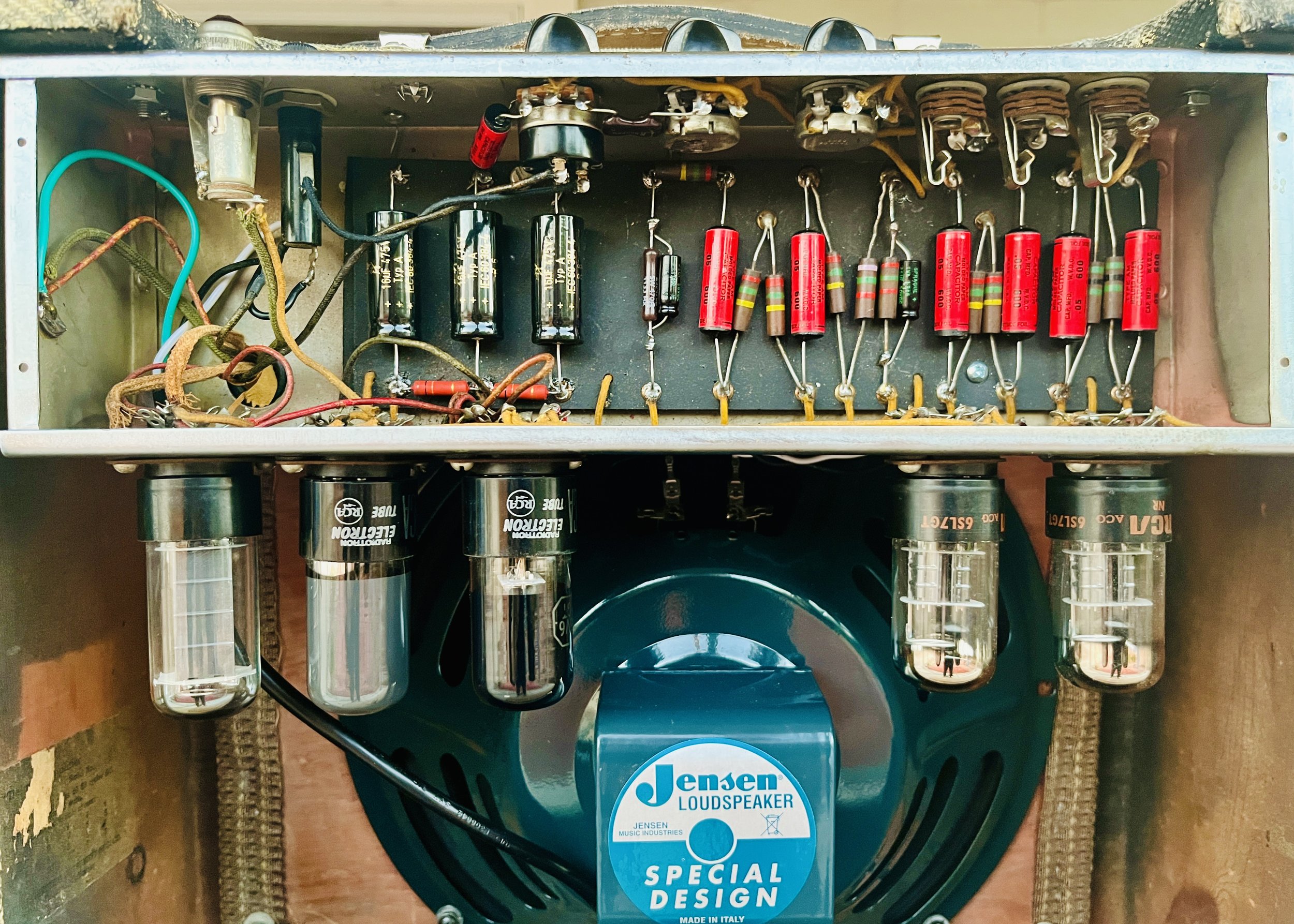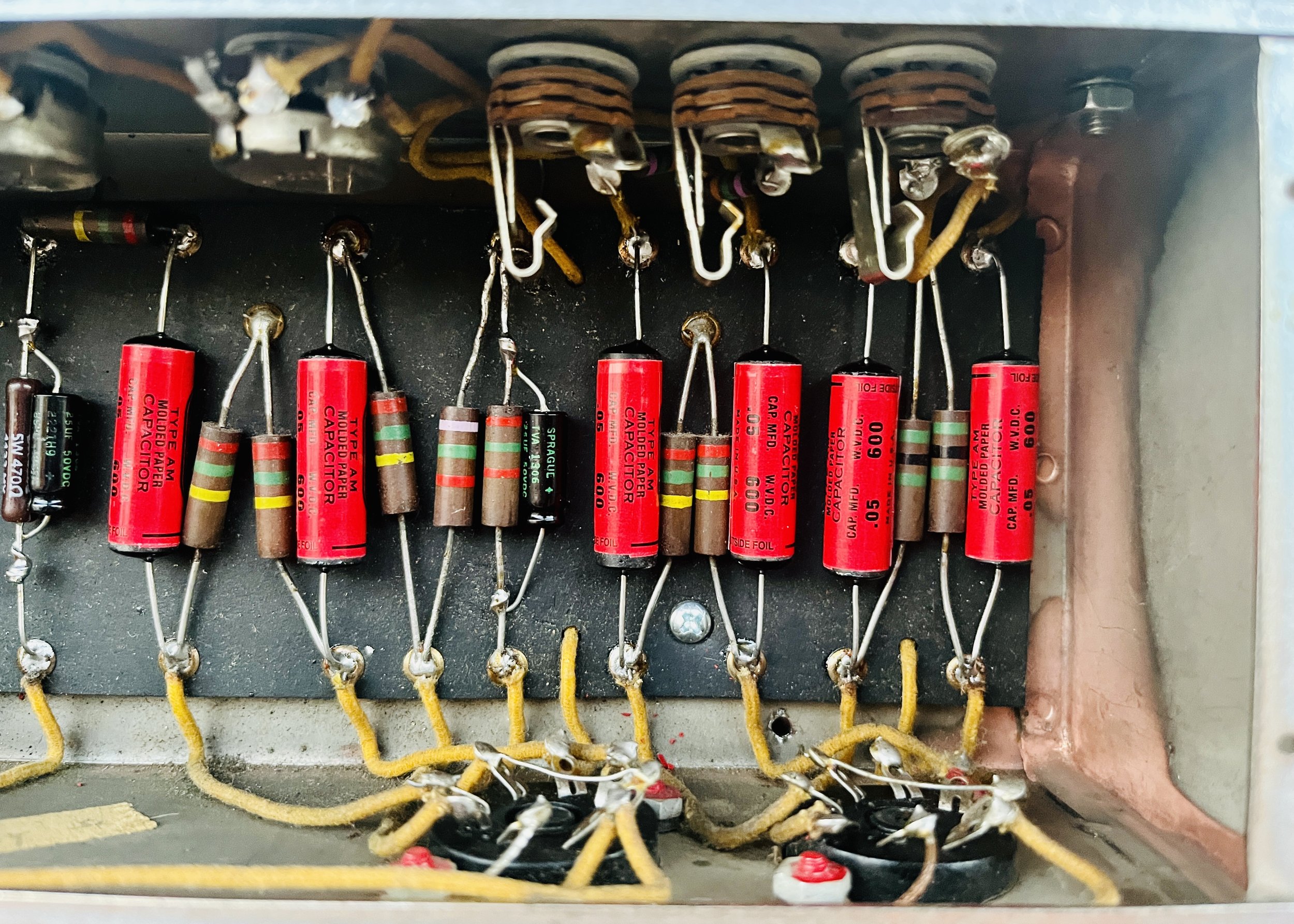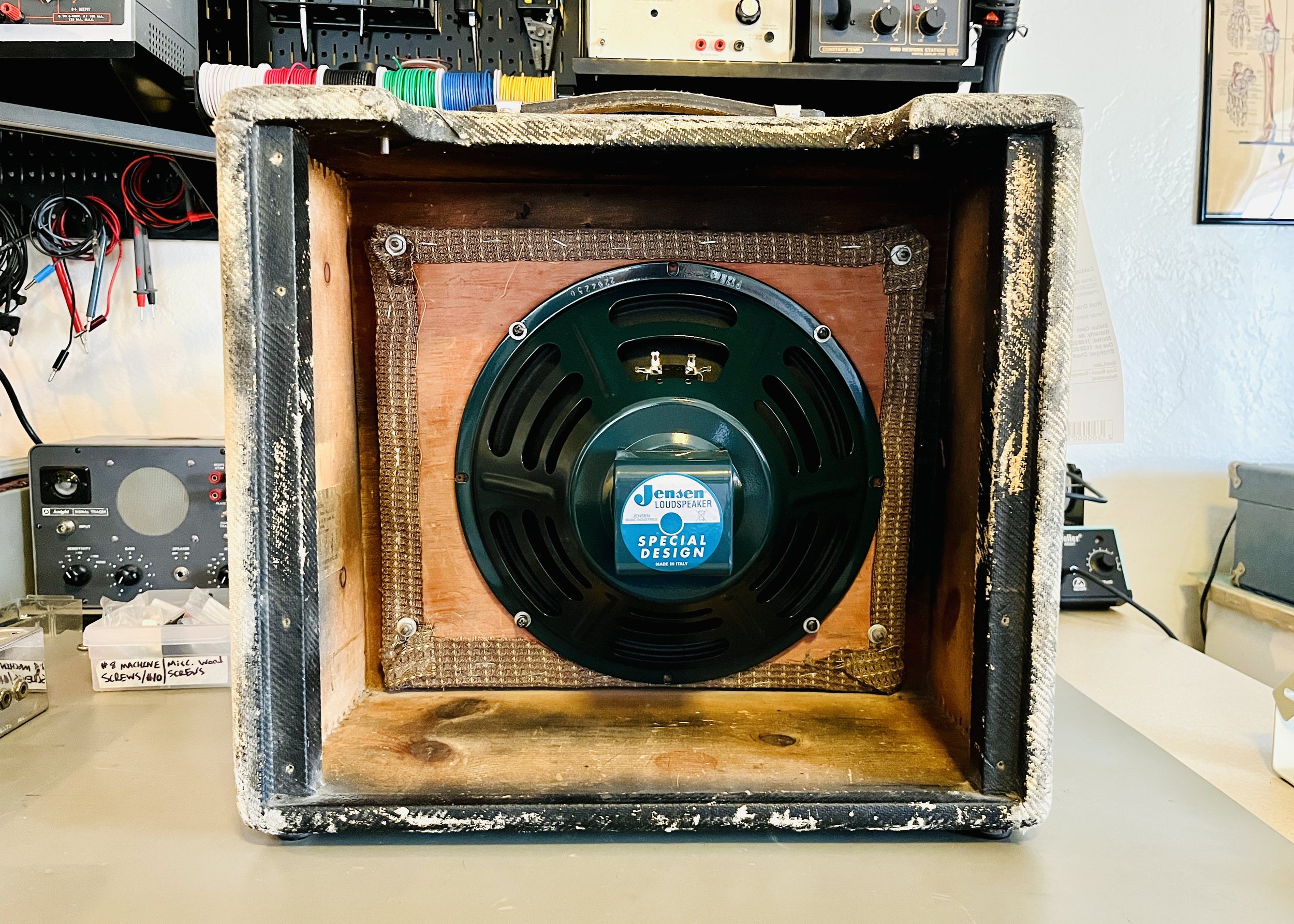1952 Fender Deluxe 5A3
This is THE amp that put Fender on the map in the early years after Leo Fender started his business and revolutionized the world of electric guitar. This amp was made before Rock music was invented. It was most popular at the time with the Blues, Country-Western, and Hawaiian Lap Steel musicians who frequented the Fender shop. This is the first Tweed Deluxe, also called the “TV Front” Deluxe due to it’s close appearance to a 1950’s Television. These amps sported an all-pine finger jointed cabinet, and a single Jensen P12R 25 Watt Alnico speaker. The tube lineup/circuit is archaic in that it features 2 6SC7’s for the preamp (this particular model has 6SL7’s from the factory) that use Grid-Leak Bias for the inputs and a Paraphase Phase Inverter downstream - these are large bottle Octal tubes, miniature 9 pin 12AX7 type tubes had only recently been invented and were not widely known yet. The 2 6V6GT’s operated in Push-Pull with Cathode Bias and no Negative Feedback provide about 14 watts of power with a lot of overdrive and compression on tap. It is all rounded out by the venerable 5Y3GT rectifier that gives the whole amp a soft and sagging power supply which contributes to the feel of this amp that so many players have loved.
5A3 Deluxe’s are not much different circuit-wise from PA systems, phonographs, or even the amplification stages of radios of the era - they sound like it too. These are not modern sounding amps with full frequency response and tight overdrive. They do not have tone or volume controls that are particulary effective or operate the way one would think. The sound isn’t even that close to the later and more iconic 5E3 Deluxe. 5A3 Deluxe’s do really sound like an old PA system and this can be bit of a shock to people expecting a 5E3 or something not so archaic in circuit design. Notable users include: Larry Carlton, Mike Campbell, Neil Young, Scotty Moore, and Don Felder.
This amp came in in what I call “Frankenstein Condition”. It had the wrong speaker, wrong Output Transformer, lots of low quality mods that didn’t work well, and the quality of the cap job and almost everything else was terrible. It also had bad tubes, leaking coupling caps, and holes drilled in the chassis. Not to mention the whole thing had been painted black and then been doused in paint thinner to remove it. Which honestly looks kind of cool, although obviously I’d love to have the original Lacquered Tweed. So a lot of work here, the customer wanted this returned to original condition and to make it an heirloom piece again. Our work was cut out for us.
Amp was completely restored with the highest quality parts possible. All filter/bypass caps were replaced with upgraded voltage and temperature rated F+T/Sprague Atom brand electrolytics - These are German/US made respectively. All coupling caps were replaced with high quality (Handmade in the USA) Jupiter Red Astron Tin Foil units to replace the original leaky and decades out of spec caps present since 1952. These caps are exact reproductions of 1950's Red Astron or Sangamo brand units originally put in Tweed Fender's. The Outside Foil markings of the Jupiter’s were all aligned to the correct junctions of the circuit - which are the ones that present the lowest impedance. This is a very old-school technique that helps prevent noise and is almost unheard of today. Most modern signal caps do not even have Outside Foil markings. New 3 Watt Metal Film power dropping resistors and 5 Watt Wire-Wound Cathode Bias resistors were installed for better reliability and lower noise floor. The rest of the carbon comp resistors tested in spec and were kept in place or saved from the low quality mods previously installed. Said mods were all taken out and original circuit values restored. This included exchanging the Tone pot with an Alpha 1M SPST switched pot as the old pot was an incorrect value replacement. Also, the bright cap was re-installed - A CDE Silver Mica unit was chosen for best tone. The hole drilled in the front panel was covered with a nickel plated chassis hole cover. Gavitt 600v Cloth Covered Wire was used were necessary to preserve the vinatge appearance of the amp.
A new Jensen Alnico P12R 25 Watt 12” Speaker was installed as the one previously in place was a replacement from a 1974 Fender Deluxe amp. The Jensen is a close reproduction of what would have came with the amp originally. The Alnico magnet provides a more dynamic response compared to the more common Ceramic magnet speaker. A new Canadian made Hammond 1750EP Output Transformer was installed - this is the correct type of OT for this amp and is an actual Paper Laminated reproduction of a 50's Tweed Deluxe OT. The one previously in place was from the same '74 Deluxe and did not have the correct Power Wattage rating or Primary Impedance needed. Phenolic Terminal Strips were used to secure the OT's wiring and provide an easier yet authentic way to disconnect the chassis from the speaker.
The original tubes did not test good and were all replaced. A new set of NOS tubes were ordered from the same era as the amp itself. The final lineup was: V1/V2 = NOS RCA 6SL7, V3/V4 = NOS RCA 6V6GT Matched Pair, V5 = NOS Phillips/ECG 5Y3WGTA. These tubes were picked for best tone and reliability. The 6V6GT’s Cathode Bias was set to 90% Class AB Plate Dissipation with a B+ of 405VDC. The tube sockets were all cleaned with a De-Oxit treatment to prevent noise from corrosion. The pots were sprayed out and the amp was cleaned inside and out. A correctly sized 2A 3AG fuse was put in replacing the over-rated fuse that came with the amp. The amp now sounds like it would have in 1952.






















